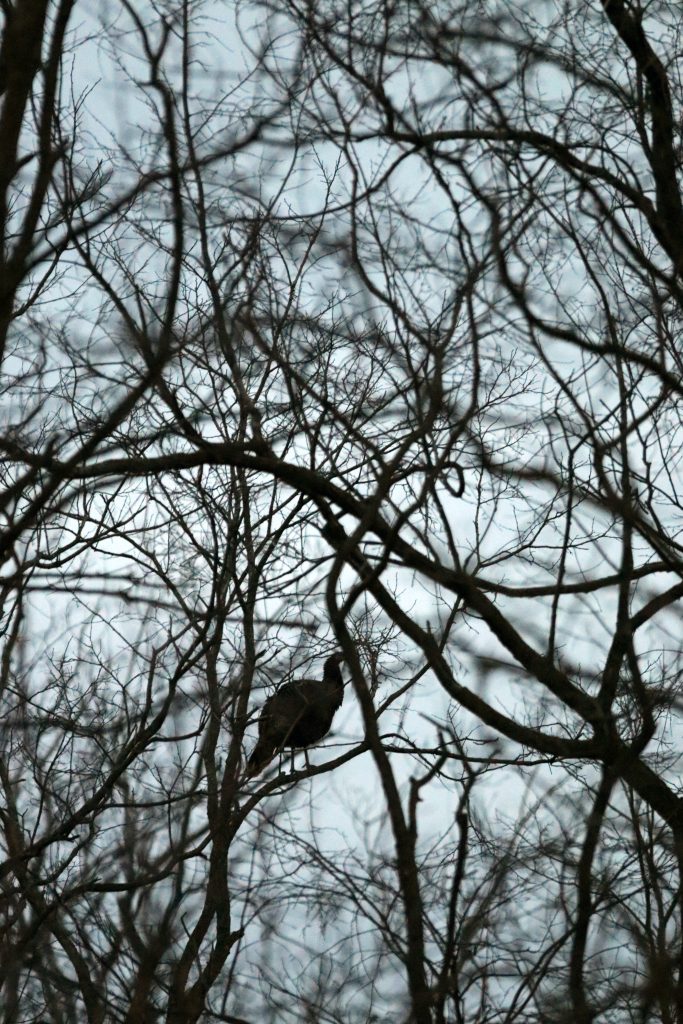Appreciating the Roost
Gobbling off to the east greeted me when I walked out of the ranch house in south Texas. A quick glance showed about three males roosted, silhouetted against the sun rising on the coast.
The interesting thing was, even though there were ample mesquite and live oaks available, these three males chose to roost on a telephone pole right next to a caliche road.
I was attending the Western Wild Turkey Technical Committee meeting, hosted by the Texas Parks and Wildlife Department. The rest of my day was spent catching and GPStagging Rio Grande wild turkeys – for science, not because it’s fun, of course. I was also pondering the importance of roosting habitat and what conditions are conducive to birds selecting a spot to roost.
Under Appreciated Housing
“Did you roost a bird,” is a common evening conversation topic passed across the table at numerous dinners and hunting camps every spring before the hunt commences. Each discussion tends to hinge on where we find birds roosted. “He is roosted down in the bottom across the creek.” Or “I saw a flock of hens fly up from the field into the cottonwoods.” We tend not to wonder why males and females roost in a particular location.
If you think about it, wild turkeys probably spend around one-third of every day on a roost. Yet, for most of us, what constitutes a roost and what drives wild turkeys to use it is unknown. My guess is there is a general lack of knowledge, and perhaps appreciation, for the role that roosting plays in wild turkey management.
Broadly, the minimum standard for roosting habitat for the eastern United States (everything to the east of the Great Plains region) is generally met. What I mean by that is that roosting infrastructure – namely trees – are plentiful and widespread.
There doesn’t seem to be any limitation on wild turkeys being able to find a place to spend the night. When we conduct research related to roost trees, we basically find the same general trends: 1) turkeys are selective to larger trees; 2) show some specificity within their ranges to certain areas for roosting; 3) individual turkeys usually don’t use the same roost location night after night, but often different groups will select and use the same locations on different days; 4) and in more northern climates, roosting locations provide some sort of thermal cover and protection from weather.
What About Out West?
Roosting ecology tends to adjust a good bit as you move west to more semi-arid regions of the United States. In regions of the central plains, roosting habitats available to wild turkeys occur in riparian corridors, but these corridors typically make up less than 5% of the total land available. Thus, from a roosting ecology perspective, what we see is that roost site fidelity, or the percentage of time birds use the same locations to roost every night, can exceed 75%. During certain wintering periods, it can approach 100%.
This high level of fidelity is driven by availability and the quality of conditions for foraging and reproductive activities around those roosting locations.

Riparian corridor maintenance in the West is a huge issue. Changes in historic flooding regimes, including the creation of water control structures, have reduced or ended flood pulses that drove the riparian landscape. Wildfires can exert considerable impact on riparian habitats since regeneration of roosting cover can span decades, even with the best conditions.
Agricultural practices can limit the availability of the ground-level riparian habitats that turkeys use. While there may be nice roost trees, the conditions in the area are not conducive to wild turkey survival or reproduction. These roost locations just fade out from non-use.
Finally, one of the largest issues we face is the explosion of invasive and non-native riparian species. We see little to no regeneration of riparian roosting habitat in many regions due to invasives such as salt cedar, eastern red cedar, giant reed, reed canary grass, Russian olive, and many other nonnative species that have been able to establish due to unfortunate introductions and changing flood regimes.
Dr. Nicholas Baker and I were recently discussing roosting ecology of wild turkeys in the southwestern U.S. He has done some interesting work showing that the direction of the slope on a hill or mountain – known as the “aspect” – can influence vegetation green-up and, hence, tree structure based on something as simple as shade regimes.
Topography, at the landscape scale, can actually define where appropriate roosting habitats are available. Probably the most distinct example of this issue is roosting ecology of the Gould’s wild turkey, where 85% of roost sites in Arizona were on north-facing slopes.
The concept of mountain shading is interesting to me as a turkey biologist, as western mountain states are generally considered to have ample forests with ample roosting sites. But, with increased wildfire activity often impacting older growth timber stands that wild turkeys select for roosting, I wonder what the implications for roost tree availability are in regions where growing takes longer and is potentially restricted to only certain areas of the landscape.
